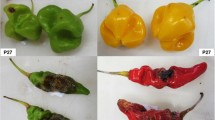Abstract
Resistance to fungal and bacterial diseases of sugarcane is a hypersensitive reaction (HR). Meristematic tissues do not respond with HR; therefore, though present in differentiated cells, HR is not useful against root rot which destroys the root tips. Resistance against this disease is an exclusion phenomenon depending on the actinomycete and fungal flora of the rhizosphere.
HR in red rot is related to the speed of activation of polyphenol oxidase (PPO) and this in turn is affected by temperature.
On juvenile leaves, following germination of spores of an avirulent strain of the red rot pathogen, diffusates contain a factor (a phytoalexin) inhibitory to the germination of other spores. Dormant infections in bud scales and leaf-scar tissue is associated with partial resistance. Accumulation of phenolic aglycones in sublethal concentrations in host cells in response to infection induces formation of dormant structures of the pathogen. Higher temperatures (Ca 32° C.) favour development of avirulent types, whereas at lower temperatures virulent types persistin vivo. Rapid degeneration of the pathogen and greater host resistance at higher temperatures explain the infrequency of red rot in tropical areas; the reverse favours the frequent epiphytotics in sub-tropical areas.
Similar content being viewed by others
References
Alexander, K. C. and Srinivasan, K. V. “Sexuality inUstilago scitaminea Syd.,”Curr. Sci.,35, 603–04.
Butler, E. J...Fungi and Disease in Plants, Thacker, Spinck & Co., Calcutta, 1918, 547 pp.
Cottrell-Dormer, W... “Red-stripe disease of sugarcane in Queensland,”Bur. Sug. Expt. Stas. (Qd.), Div. Path. Bull., 1932,3, 25–59.
Cruickshank, I. A. M. and Perrin, D. R. “Isolation of a phytoalexin fromPisum sativum L.,”Nature, Lond., 1960,187, 799–800.
Flentje, N. T... “Studies onPellicularia filamentosa (Pat.) Rogers. III. Host penetration and resistance, and strain specialization,”Trans. Brit. mycol. Soc., 1957,46, 322–36.
Hooker, A. L... “Correlation of resistance to eightPythium species in seedling corn,”Phytopathology, 1956,4, 175–76.
Lee, H. A... “The toxic substance produced by the eye-spot fungus of sugarcane,Helminthosporium sacchari Butler,”Pl. Physiol., 1929,4, 193–212.
Martin, J. P. and Robinson, P. E. “Leaf scald” in Martin, J. P., Abbott, E. V. and Hughes, C. G.,Sugarcane Diseases of the World, Vol. I, Elsevier Publishing Co., Amsterdam, 1961, pp. 79–107.
Mizukami, T... “Observations on the reactions of plant to the infection of some pathogens. I. On the influence of the barley juice on the germination ofFusarium nivale andFusarium solani,”Ann. phytopath. Soc. Japan, 1953,17, 57–60.
Müller, K. O... “Über die Entwicklung vonPhytophthora infestans auf anfalligen und widerstandsfahigen Kartoffelsorten,”Arb. biol. Reichsanstalt. Land.-u. Fortswirtsch. Berlin-Dahlem, 1931,18, 465–505.
—————.. “Einige einfache Vers che zum Nachweis von Phytoalexinen,”Phytopath. Z., 1956,27, 237–54.
—————.. “Studies on phytoalexins. I. The formation and immunological significance of phytoalexin produced byPhaseolus vulgaris in response to infections withSclerotinia fructicola andPhytophthora infestans,”Austr. J. biol. Sci., 1958,11, 275–300.
—————.. “Hypersensitivity,” in Horsfall, J. G. and Dimond, A. E.Plant Pathology—An Advanced Treatise, Vol. 1, Academic Press, New York, 1959, pp. 469–519.
—— and Börger, H... “Experimentelle Untersuchungen über diePhytophthora-Resistenz der Kartoffel,”Arb. Biol. Reichsanstalt. Land-. u. Fortschwirtsch., Berlin, 1940,23, 189–231.
Simmonds, J. H. “Latent infection in tropical fruits discussed in relation to the part played by species ofGloeosporium andColletotrichum,”Proc. roy. Soc. Qd, 1940,52, 92–120.
—————.. “Studies in the latent phase ofColletotrichum species causing ripe rots of tropical fruits,”Qd. J. agric. Sci., 1963,20, 373–424.
Singh, R. K... “Comparative study ofFusarium moniliforme Sheldon andCephalosporium sacchari Butler,”Sci. & Cult., 1958,24, 135–37.
Skoropard, W. R. and Arny, D. C. “Histological expression of susceptibility and resistance in barley to strains ofHelminthosporium gramineum,”Phytopathology, 1956,46, 289–92.
Srinivasan, K. V. .. “Studies in the microflora of the rhizosphere of sugarcane”Ph.D. Thesis, Madras Univ., 1959.
----- .. “Screening for red rot resistance at an early stage of growth of sugarcane settlings,” Abs. inProc. agric. Acad. Sci., Coimbatore, 1961.
Srinivasan, K. V. “Some observations on variation in the red rot pathogen,Glomerella tucumanensis (Speg.) Arx. & Müller,”Proc. intern. Soc. Sugarcane Tech., Mauritius, 1963,11, 795–802.
————— “Some observations on sugarcane wilt,”J. Indian bot. Soc., 1964,43, 397–408.
----- “Hydrolytic enzymes and polyphenol oxidase in sugarcane red rot,”International Symposium on Plant Pathology, Session on “Phytotoxins and Fungal enzymes,” New Delhi, 1966.
-- and Alexander, K. C. “A study of mode of infection and occurrence of dormant infections of red rot,”Proc. 5th All India Conf. Sugarcane Res. and Dev. Workers, 1965, pp. 675–84.
Steib, R. J. and Chilton, S. J. P. “Infection of sugarcane stalks by the red rot fungus,Physalospora tucumanensis Speg.,”Phytopathology, 1951.,41, 522–28.
Western, J. H... “The biology of oat smuts. IV. The invasion of some susceptible and resistant oat varieties, including Markson, by selected biological species of smut,”Ann. appl. Biol., 1936,23, 245–63.
Author information
Authors and Affiliations
Additional information
Approved for publication by the Director, Sugarcane Breeding Institute, Coimbatore-7.
Rights and permissions
About this article
Cite this article
Srinivasan, K.V. Physiology of disease resistance in sugarcane with particular reference to red rot. Proc. Indian Acad. Sci. 69, 120–132 (1969). https://doi.org/10.1007/BF03052519
Received:
Issue Date:
DOI: https://doi.org/10.1007/BF03052519



